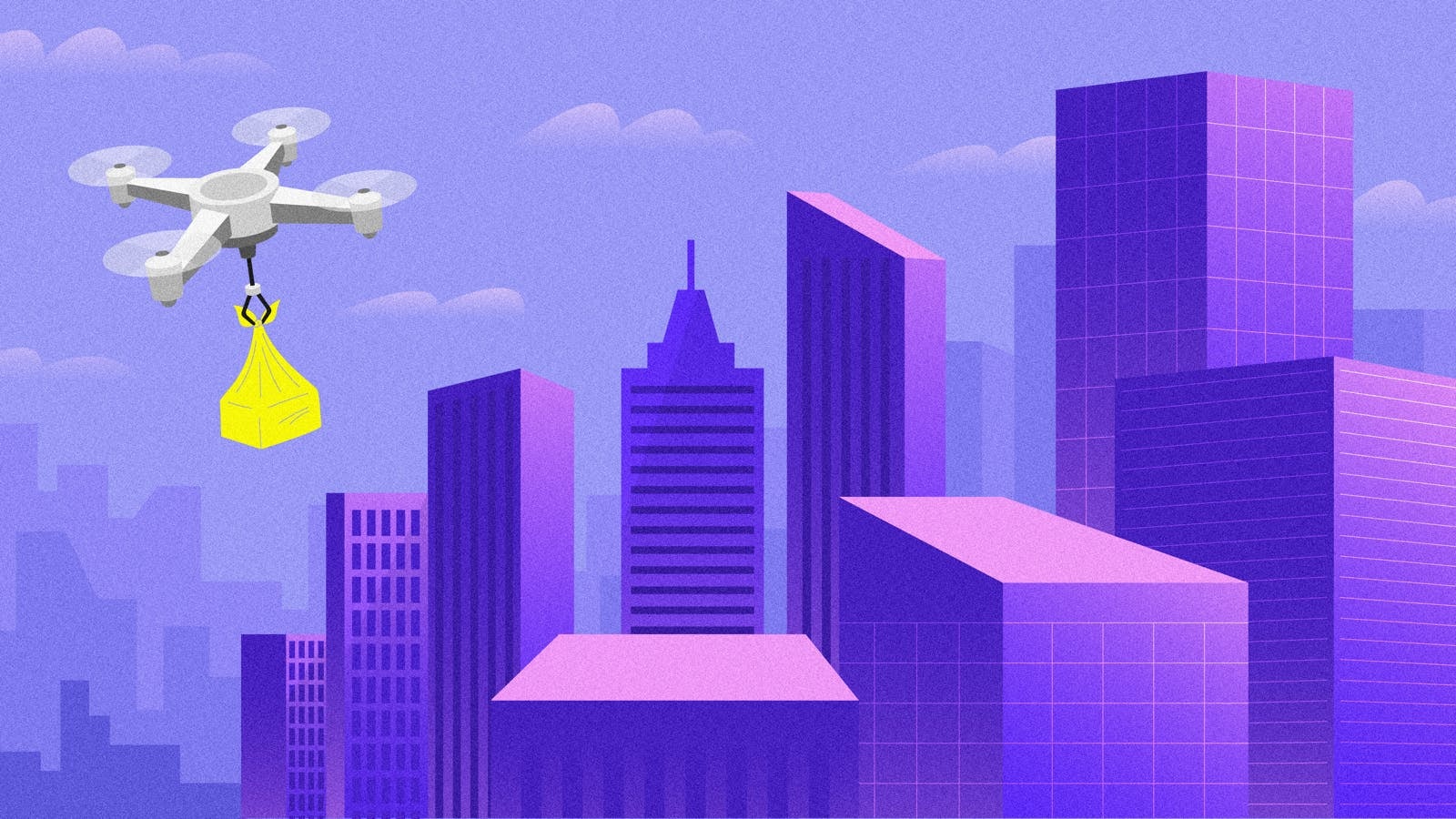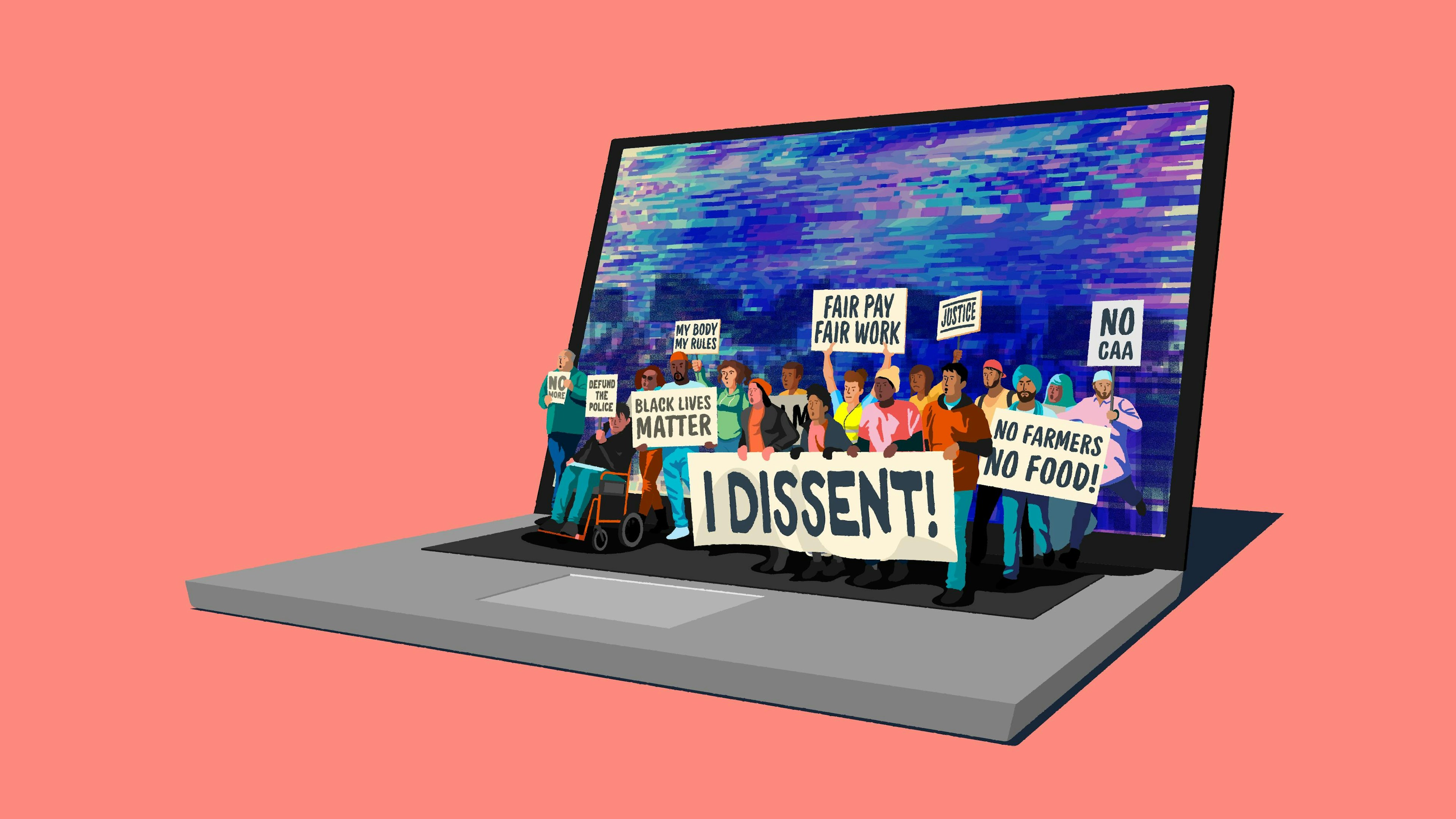The tangled web between e-commerce and package delivery

TOPICS
Community ShiftsHad a package delivered lately? Did it go well or poorly? Package delivery is a direct illustration of how our online world has altered offline realities.
Features as simple as same-day delivery don't always manifest elegantly in physical space. But most of the time, seeing the throughline between a smooth delivery and, say, higher urban pollution feel abstract. That's deliberate: The act of pushing a “buy now” button is cunningly designed to hide the physical machine you've enlisted to fulfil your request.
There are occasional glitches in the matrix. It may strike you as odd when a retailer sends you a new pair of shoes … without you returning the oversized ones you ordered, because the logistics of exchanging them are more expensive than the shoes' value. Or maybe something small arrives in a massive box, which contains a Matryoshka of smaller boxes. (Uniformly sized packages are easier to expedite along factory lines. The surprising amount of waste you receive, in exchange for that efficiency, is your problem.)
Xianzheng Fang, an urban planner in China, did his masters thesis on the impact of e-commerce on cities and villages worldwide. Highlighted for outstanding work at Tufts University in 2020, he focused on five major ways e-commerce impacts environments: Through traditional retail, logistics and transportation, economy, sustainability and urban planning.
“Some parts [are] perceived in daily life,” he says, “like traffic jams caused by delivery trucks, more and more empty brick-and-mortar retailing storefronts, special rooms for receiving packages in today’s apartments, and curbside trash bins overflowing with delivery boxes.”
This is not only unsustainable and unsightly, but inefficient and dangerous. Fang found that nearly half of freight trucks in downtown Seattle park illegally when delivering packages. To find parking, they otherwise spend anywhere from 28-71 percent of delivery time circling blocks. Illegal parking exacerbates traffic and air pollution, heightening the risk of accidents. The situation’s bad in New York City too.
Closer to Fang's home, Shanghai’s Information Office recorded 324 traffic accidents, five fatal, caused by delivery drivers in the first half of 2019. This has likely gotten worse; in the first few years of the COVID-19 pandemic, package deliveries shot up by a world average of 25 percent.
But drivers shouldn’t shoulder the blame; that distracts from infrastructural issues. Parking is scarce in cities, especially for trucks, and there’s a business incentive to move fast. “Online sellers always want to get orders to customers as soon as possible,” Fang says, “which in turn puts extra pressure on drivers and makes the situation worse.”
Customers are less concerned with these logistics. The most common problem they encounter in the e-commerce chain is package theft. “It’s an urban problem, it’s a suburban problem,” says Sid Khattri, co-founder and CEO of Vertoe, the parent company of last-mile package delivery solution Stowfly. “Porch pirates are everywhere now.”
The term “last mile” refers to the final steps of parcel delivery, from the nearest warehouse to the customer. Citing Stowfly research, Khattri observes that 1 in 10 packages don’t make it to US customers on the first try, due to theft, or missed dropoffs/pickups. Either way, Khattri adds, both create terrible customer experiences while racking up inefficiencies and carrier vehicle miles.
Other sources cite larger figures: According to a March 2022 study by Security.org, nearly 1 in 4 people reported a package theft in the past three months, with over half reporting ever having a package stolen. That’s not only bad for the customer, Khattri notes, but everyone else in e-commerce. The retailer, too, must bear the loss.
Hands off my locker
The solution to thefts, and to the clogging of trucks on city streets, has generally been locker technology: Having your package delivered to a secured locker in an accessible location. But in the United States, the only real chance of getting a dependable locker is by buying a product from Amazon.
Khattri observes that Wal-Mart attempted to compete, installing a few lockers in select locations, but its system is nowhere as developed as Amazon’s. Hybrid retailers—those with physical and online stores—don’t have a material incentive to address complex e-commerce issues on a large scale.
“They want to force customers to get their packages delivered to the nearest store,” Khattri says, “because they know this person is going to come in and probably buy some other stuff. That’s why I believe Wal-Mart has intentionally not executed [their lockers] well.”
What’s more, Amazon’s locker feature is more discoverable than any other carrier’s. FedEx and UPS options exist, but are hard to find. “To give the best experience to the customer, you need to have 100 percent discoverability of this amazing feature,” Khattri adds.
The option has to be shiny and clear at virtual checkout. That’s not the case for UPS or FedEx. To use one of their lockers, there are several steps: The retailer must assign your package to a carrier. You must be a registered user of that carrier. Lastly, you must receive their emails, which most people don’t read (this vlogger in Ohio describes why UPS Point Access “is trash”).
As a result, 99 percent of people are not even aware that lockers are a feature. Compare this to Amazon, which tells you at checkout there’s a locker nearby. “That is 100 percent discoverability, so what’s the point of creating a solution that 99 percent of people don’t know about?” Khattri says.
Amazon was once as wonky as UPS and FedEx are now. But it rapidly began developing a locker network once it understood the solution's value. “They’ve made the most progress and tried to give the best experience, but all retailers are not Amazon,” Khattri says; the rest must bear UPS and FedEx’s broken systems. This undermines the last-mile solutions lockers promise in the first place.
Last-mile solutions could live up to what they purport to be if they were easier to use, more discoverable, and truly retailer agnostic. In Khattri's view, we’re unlikely to get there without government support.
Making it to the last mile
If a package can arrive on your doorstep in a few days, many will choose that convenience, even if what they’re looking for is at a shop nearby. Besides running local businesses into the ground, this has drastic consequences for the future of communities. “The retail landscape being reshaped by e-commerce will give rise to radical change in real estate,” Fang says. We’ve already begun to see the consequences across North America, from Mexico and California, to Iowa and Pennsylvania.
E-commerce's current large-scale approach to parcel delivery exacerbates waste and carbon emissions. International conglomerates have forced smaller businesses to adapt or die, and play a role in our changing sense of place and community.
But countries and communities around the world are developing a panoply of compelling solutions to these symptoms of unbridled growth.
Stowfly, based in the US, is one. Inspired by the embarrassingly bad management of e-commerce in the US, Khattri and his team formed a network of shops where people can store and collect parcels without fear of theft. Unlike Amazon, Stowfly partners with mom-and-pop outlets while remaining retailer-agnostic. You don’t need to buy a product from Stowfly to use a Stowfly locker, and its small-business relationships help local shops see more foot traffic.
For Khattri, e-commerce solutions must include an integrated, carrier-agnostic locker system. They save delivery time and corresponding carbon emissions, compared to the individualised door-to-door method. In turn, they’re key to cutting the last mile.
Without support and policy regulation, Amazon will likely continue to lead as a locker solution in the US, in effect requiring all deliveries to be Amazon products. Khattri looks to systems in countries like Poland, Sweden, and Singapore, which are moving towards “the most evolved model” of these locker systems.
In Poland, the growth of locker service InPost has made the country “Europe’s most innovative delivery market,” according to Marek Różycki of Last Mile Prophets. In July 2022, it announced plans to expand to other European countries.
“This all would not have been possible without the pandemic,” says Maja Kiba-Janiak, associate professor of economics at Wroclaw University of Economics and Business. InPost has existed for about two decades, but when COVID-19 hit the country it offered the contactless, outside pickup that made getting what people needed safer and less nerve-wracking. Some gleefully show how it works through homemade videos on YouTube.
A similar instalment is Sweden’s Instabox. With its motto of “uncomplicated shipping,” Instabox works with select online retailers to deliver packages to hundreds of “smart boxes,” often on the same purchasing day.
These solutions aren’t without flaws. Poland, for example, is seeing an overcorrection. “There are just too many parcel lockers showing up on the streets,” Kiba-Janiak says. Companies competing with InPost have developed their own lockers and designs, side-by-side on the streets.
“If you have, for example, three or four different lockers alongside each other,” says Różycki on Last Mile Experts, “then instead of having a very efficient drop of one courier, one hundred parcels, one van, less carbon, et cetera per parcel, you’ll end up with four vans taking twenty-five each.” This is a perfect example of a “solution” exacerbating the same problems—crowding, traffic, vehicle emissions—it set out to solve.
One remedy, Kiba-Janiak says, involves working with companies to create uniform locker designs, with different companies renting locker spots. Różycki agrees: “It’s a case of either the incumbents [regulating] themselves and [finding] a way to create a solution that is optimal from the perspective of operations capacity and congestion,” he says. If not, a regulating body like the government must step in.
The government has interceded in places like Singapore. Its Locker Alliance combines different parcel locker networks and delivery companies, leading to a 50 percent reduction in delivery drivers’ distance traveled, and an increase in parcels delivered per day.
Research is ongoing on how to optimise these systems, but Różycki argues that systems like Singapore’s show why carrier-agnostic parcel lockers “are the future.”
Could blockchain solutions help close the distance?
Khattri emphasises that agnostic solutions, with bigger goals in mind than profit, are necessary. “Even if it’s not Stowfly, whoever builds this has to for all retailers and shoppers in the country, for the ultimate goal of stopping package theft, making fewer deliveries, reducing congestion, and creating a more sustainable e-commerce ecosystem.”
When it counts, people could still get packages as quickly as Amazon promises. “Except that instead of your apartment door, it’ll be at the locker, or from the retailer on your block,” Khattri says.
If pick-up points are within walking distance from your home, or near a stop on public transport, that may feel like an invitation for you to go about town without a car. It would invite investment in environmental accessibility, and maybe beautification, making public spaces more pleasant and walkable—more tree-filled than parking lot-filled.
Since the US prefers private intervention to address infrastructural issues, at least for now, blockchain-based solutions may bode well. The Decentralized Autonomous Vehicles (Dav) Network, which uses blockchain technology to enable vehicles to “discover, communicate, and transact” with one another using Dav tokens, could provide practical and localised solutions to e-commerce’s cascading consequences for communities.
People and services can exchange Dav tokens to transport a package, or even a person (in the case of ride-hailing), from one place to another. Dav systems imagine peer-to-peer, localised networks that eschew dependence on big trucks, or a centralised body, for solving the last-mile problem.
Big vehicles will still be needed for heavy loads, but most deliveries—food, small products, that coffee mug you saw on Instagram—can be dispersed to local delivery people. These could be community members with electric vehicles, motorbikes, drones, or bicycles, making a buck while distributing things where they need to go.
Because Dav solutions exist on the blockchain, it's theoretically impossible to manipulate the underlying technology to corrupt market signals—as former Uber CEO Travis Kalanick did, when he used investment cash to make Uber's rideshare prices appear lower than competitors', only to raise them once competitors edged out (all while reducing drivers' pay). Dav is autonomous, (hypothetically) incorruptible, and retailer-agnostic in ways that a private company cannot be.
In the reality Dav networks conjure, we wouldn’t have to deal with FedEx or UPS, either. And local people or businesses could even package in more practical, sustainable ways, especially for deliveries to recipients at close proximity.
Post-pandemic confinement, and even without large-scale Dav networks, this has already begun happening in some communities. The Naked Shop, a waste-free cosmetics and homewares store in Paris, France, uses a third-party bike service to fulfil e-commerce deliveries within the city and nearby suburbs. Because its deliveries don’t interact with postal services or factories, products often come in reusable cloth, glass or baskets, which can be returned and reused for future orders.
How does that compare to ordering a body wash on Amazon, and having it arrive in miles of bubble wrap and four boxes?
Whether the solutions look like Davs, or merely more organic partnerships close to home, they physically conjure something closer to what e-commerce tacitly offers, with its focus on "clean" UX design and one-click sales: Equally clean and ergonomic spaces in the world, enriched and not embattled by our presence.
Let's return, briefly, to Khattri, who in many ways aspires to Stowfly's dissolution. “The final vision is a truly carrier- and retailer-agnostic location network,” he says. “Now whether that’s through lockers, local shops, or a combination, it has to be truly carrier- and retailer-agnostic.”
There’s expertise backing his approach. In “Only an Ecosystem Can Solve Last-Mile Gridlock in Package Delivery," published in June 2021, Boston Consulting Group estimates that the type of network Khattri hopes to build would lead to a 66 percent decline in carrier vehicle miles, and a 15 percent decrease in the cost of each package delivered. In other words, this kind of coherent constellation could support more efficient e-commerce—less wasteful, and cheaper for all.
Investments in “green” technologies, like energy-efficient delivery vehicles and public transportation, are another key to this puzzle. But work by researcher Magdalena Mucowska reinforces Khattri's point: Lasting answers to the packaging problem—which belies how severely we underestimate the spillover between our virtual worlds and messy meat-space—must be all-encompassing, from vehicle routing optimisation to the desire to create, and inhabit, walkable communities.
03 Aug 2023
-
Sarah Simon
Header illustration by Debarpan Das.
Endless tomorrows, delivered weekly to your inbox.
02/03
Related Insights
03/03
L’Atelier is a data intelligence company based in Paris.
We use advanced machine learning and generative AI to identify emerging technologies and analyse their impact on countries, companies, and capital.


